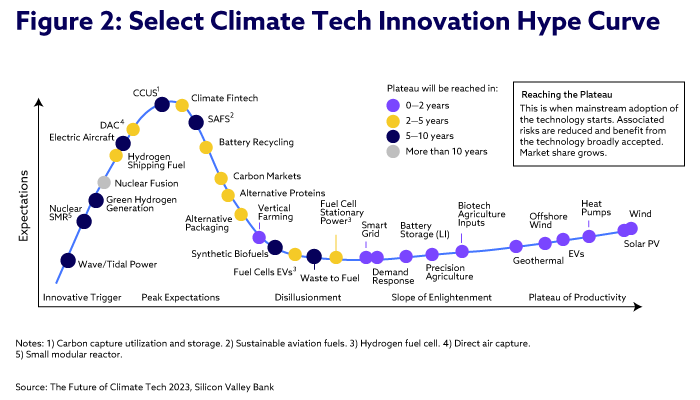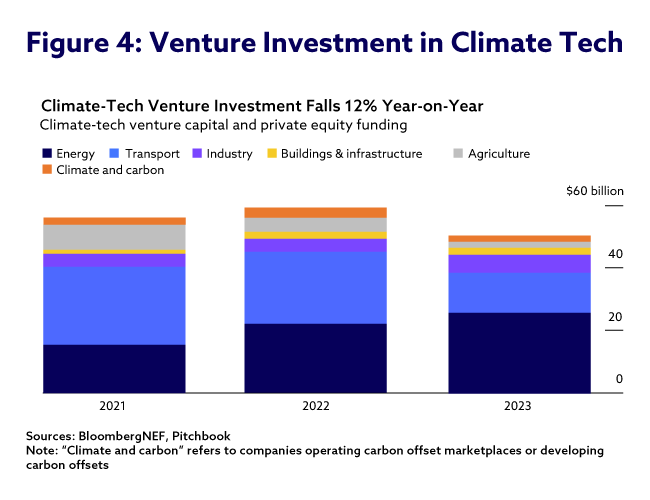Governments and the private sector are supporting climate technology. Learn why net zero is the future.
Overview
Emerging climate technologies will serve an indispensable role in decarbonizing the planet. According to the latest Net Zero Roadmap from the International Energy Agency (IEA), around 35% of the emissions reductions needed to meet the goals of the Paris Agreement will need to come from technologies that have yet to be commercially deployed.
The remainder will need to come from scaling up proven technologies that are still not cost competitive compared to their traditional counterparts (see Figure 1), such as electric vehicles (EVs).

Most of these technologies are several years away from going to market or passing the threshold where they begin to scale rapidly (see Figure 2). They include breakthroughs in energy efficiency in industry, agriculture and consumer products; long-duration energy storage; carbon dioxide removal (CDR) technologies, including carbon capture, utilization and storage (CCUS); green hydrogen; sustainable fuels; methods to turn waste into energy; and advanced nuclear small modular reactors.

Whereas new technologies usually gain a foothold in the market by offering superior functionality or lower cost, emerging climate tech generally does the same thing as the higher-carbon technologies or processes it is seeking to displace, but at a considerably higher price.
“Sustainable aviation fuel, green steel and green concrete perform the same functions as their traditional counterparts,” said David von Eiff, Director, Global Industry Standards at CFA Institute. “And for the foreseeable future, they will be more expensive.”
That price difference could be a make-or-break impediment in the global race to net zero.
Economies of Scale
The good news is that the costs of emerging climate tech are – based on historical trends – widely expected to diminish over time as they become more widespread. Consider solar and wind power, which at the dawn of the millennium seemed prohibitively expensive. But as these technologies reached sufficient scale, costs began to decline rapidly – by a global weighted average of 89% for solar and 69% for onshore wind between 2010 and 2022, making them cost-competitive with fossil fuels even without financial support in many cases.
That tipping point probably could have come much earlier. One model produced by researchers suggested that, had an extra USD5 billion of investment gone into solar from 1985-1990 (see Figure 3), it could have brought the cost by 1990 to nearly half of what it was, and solar would have scaled sooner and started displacing fossil fuels eight years earlier.
Put another way, the sooner we channel more investment into new and emerging climate tech today, the earlier we will arrive at net zero.

The Allure and Challenge of Investing in Climate Tech
- Technical risks: These include technology feasibility, scalability, performance, reliability and compatibility. Investors need to determine whether these technologies are effective, efficient and safe.
- Cost assumptions: Although it is generally assumed that production and operating costs of these technologies will continue to come down, as they did with solar and wind, that is not a given.
- Funding runway: Will these technologies be able to attract sufficient capital or subsidies to see them through to breaking even? Based on historical trends, McKinsey estimates that climate tech could take about seven years to achieve scale, compared to an average of three years for digital marketplaces.
- Commercial risk: Will there even be demand for these technologies when they go to market, or once supportive measures are scaled back? EV sales, for example, slowed considerably (if temporarily) when subsidies and tax credits were halted.
- Arrival of superior alternatives: As an extreme example, nuclear fusion could render all other clean energy technologies obsolete. To date, USD6.2 billion has been invested in the technology in the hopes it will revolutionize energy production.
Despite these risks, climate tech companies raised USD51 billion in venture capital and private equity funding across more than a thousand deals tracked by BloombergNEF in 2023 (see Figure 4). Encouragingly, although this was 12% lower than the previous year, it was much less of a decline than the 35% funding drop reported for all startups.
But it is still far short of what is needed. To hasten innovation and cut costs in these emerging climate technologies, McKinsey estimates that investments would need to grow by about 10% each year to reach approximately USD2 trillion by 2030.

Policy Support

Each of these categories can provide considerable support to climate tech:
- Carbon pricing boosts demand by increasing the value of emissions reductions offered by climate tech.
- Incentives can mobilize markets. Take the US Inflation Reduction Act (IRA): introduced in 2022, it is expected to drive more than USD1 trillion in domestic investment in power generation, hydrogen and CCUS up to 2027.
- Transition guidance and clarity on carbon intensity goals better enable investors to quantify the attractiveness of climate tech, such as CCUS.
- And clear standards and taxonomies help to protect the integrity of green products and services, and avoid greenwashing concerns.



